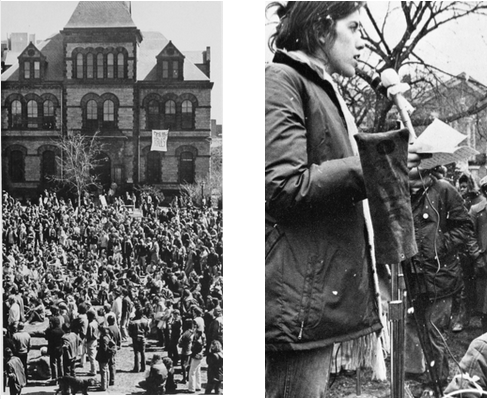Tumultuous Times: 1970s
In the years after 1968, when Lamphere arrived at Brown, powerful social forces were roiling the nation and the campus. These included activism against the Vietnam War, the movements for civil rights and women’s rights, and a national economic crisis. Locally, the university was adjusting to co-education, once The College (men) and Pembroke College (women) merged in 1971. Articles in the March 13, 1975 issue of the Brown Daily Herald reflected these issues.
CIVIL RIGHTS
Photo by Cecil Stoughton. The Lyndon Baines Johnson Presidential Library
The Civil Rights Act of 1964 (signed by President Lyndon B. Johnson) prohibited employment discrimination on the basis of race, color, religion, sex, or national origin. Congressional hearings before the law's passage had focused primarily on race-based civil rights.
Photo by Warren K. Leffler. U.S. News & World Report Collection, Prints and Photos Division, Library of Congress
Rep. Martha Griffiths, a Michigan Democrat, pushed intensively for the last-minute inclusion of sex discrimination in Title VII of the landmark civil rights law.
Women's Movement
American Association for University Women (AAUW) Equal Rights Amendment Rally, 1978. AAUW Archives, Washington, D.C.
The women's movement of the 1960s and 1970s challenged the unequal status and treatment of women - from the national political stage (through activism such as demonstrations in favor of the Equal Rights Amendment) to the experiences of daily life (through advocating for changes such as access to the birth control pill).
Ortho Pharmaceutical, 1973. Dittrick Medical History Center, Case Western Reserve University
The women's movement also affected college campuses, including Brown, by fostering interest in the study of women as an area of teaching and scholarship and heightening awareness of professional inequities facing women faculty. As at other universities around this time, activism by Brown students and faculty such as Lamphere, Mari Jo Buhle, and Anne Fausto-Sterling was crucial to introducing women's studies courses in the face of resistance by other faculty. The 1973 syllabus shown here is from one of Brown's earliest courses in women's studies.
Anne Fausto-Sterling
Photo by John Foraste. Brown University Archives
Mari Jo Buhle
Photo by John Foraste. Brown Alumni Monthly
Economic Crisis
Photo by Warren K. Leffler. U.S. News & World Report Collection, Prints and Photos Division, Library of Congress
In 1973, long lines were a common sight at American gas stations. An oil embargo by the Arab member countries of the Organization of Petroleum Exporting Countries (OPEC) against the United States caused gas prices to skyrocket. Beyond the inconvenience of gas rationing, the energy crisis created an economic strain that was felt across the country, including at Brown.
National hardship stemming from the energy crisis took its toll on Brown. To address dramatic financial difficulties, the administration mandated faculty cuts across departments. The burden fell on untenured faculty members, and since most women and minority faculty were in junior positions, the cuts disproportionately affected these groups. It was in this climate that Lamphere went up for tenure.
Sparked by war and then the economic crisis, some students engaged in activism on campus. Students organized a strike following the United States invasion of Cambodia in 1970 and the killing of student protesters by National Guardsmen at Kent State. In 1975, students protested President Hornig's proposed budget cuts by striking and picketing University Hall.







